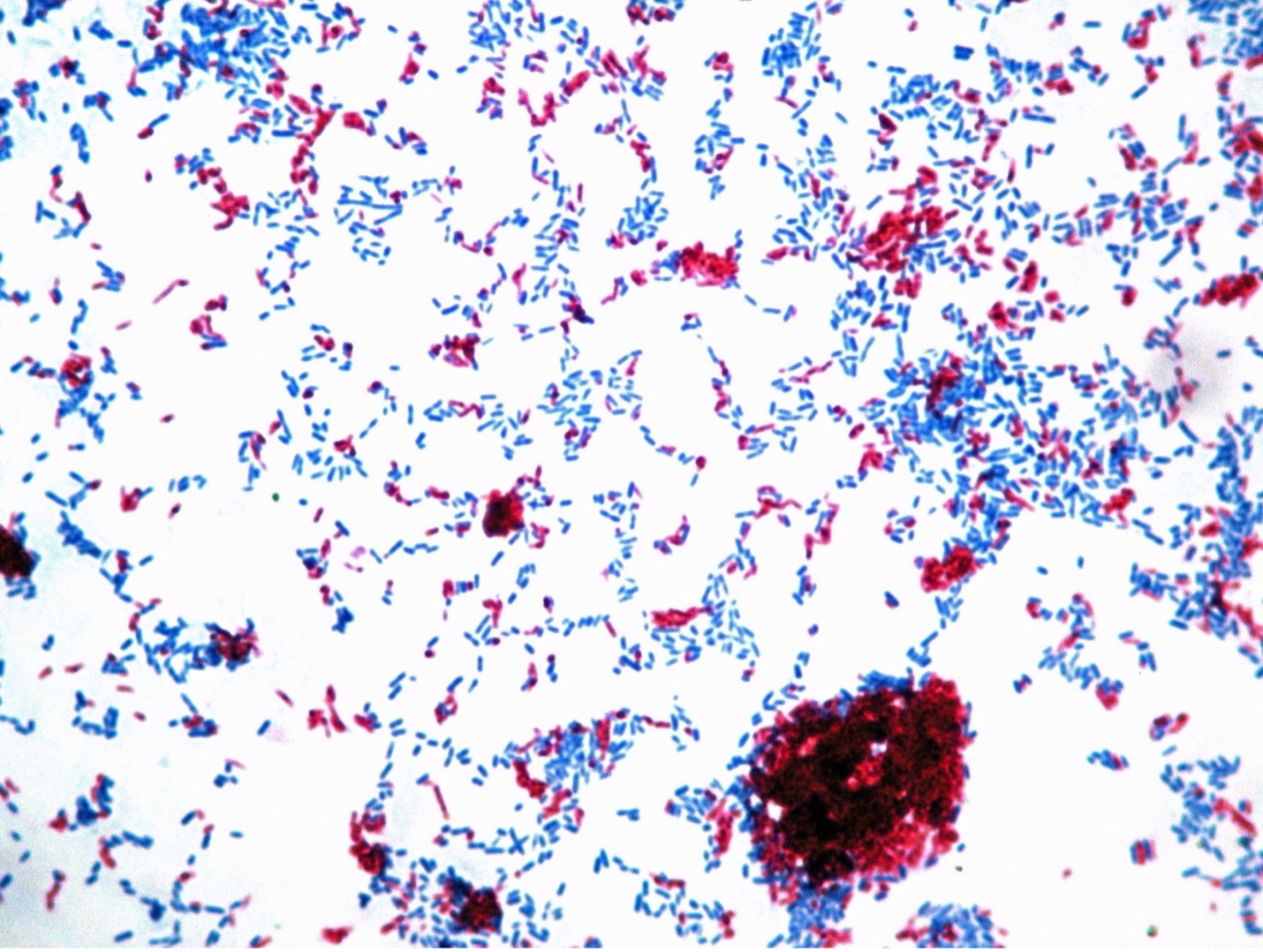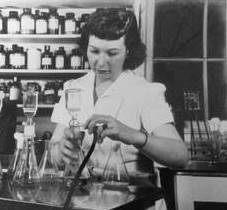Acid Fast Stain Staphylococcus Aureus
10
Perform an acrid-fast stain
Distinguish acid fast from non-acid-fast organisms
Explain why some bacterial cell walls cannot exist stained with traditional Gram stain
Discuss how the acid-fast can be used to identify microorganisms and why information technology is an important tool in clinical settings
Identify structural characteristics of the major groups of microorganisms
Compare and dissimilarity prokaryotic cell and eukaryotic cells
Compare and contrast the physiology and biochemistry of the various groups of microorganisms
Utilize aseptic technique for safe handling of microorganisms
Utilise various laboratory techniques to identify types of microorganisms
Stock cultures:
TSA slant of Mycobacterium smegmatis
TSB goop of Escherichia coli
Equipment:
one glass microscope slide per person
Inoculating loop
Microscope
Stains:
Carbolfuchsin
Acrid-alcohol, decolorizer
Methylene blue
The acid-fast stain was developed in 1882 by Paul Ehrlich to aid in the diagnosis of tuberculosis (TB). Ehrlich observed that dyes were non absorbed by Mycobacterium unless the organism on the slide was heated. Once the dye was captivated, the jail cell wall retained the dye fifty-fifty when the smear was washed with a mixture of acid and booze (iii% muriatic acid and 95% ethanol).
The prison cell wall of leaner Mycobacterium, Nocardia and parasite Cryptosporidium contains large amounts of glycolipids, especially mycolic acids. This unique prison cell wall enables them to resist staining and makes them resistant to many common disinfectants. Information technology is the mycolic acid that makes information technology difficult to blot dye into the prison cell. However, once the dye penetrates the cell wall (by using oestrus or chemicals such equally phenol), these glycolipids prevent acrid-booze from decolorizing the cell. Therefore, these organisms are said to be "acid-fast". Most bacteria, such as Due east. coli and Staphylococcus, lack this loftier mycolic acrid content and are easily decolorized by the acrid-alcohol. Therefore, these organisms are described as "non-acid-fast". They absorb the counterstain, methylene blue. The acid-fast stain is therefore a differential stain since it uses two dyes to distinguish 2 groups of organisms based on the mycolic acid in their cell walls.
There are 2 methods of acid-fast staining. The Ziehl-Neelsen stain uses steam to penetrate the mycolic acid in the cell walls, whereas, Kinyoun uses a very concentrated dye, hard heat fixing, and longer exposure fourth dimension.
Several species of Mycobacterium and Nocardia are pathogenic for animals and humans. Mycobacterium tuberculosis causes TB and is one of the world's deadliest diseases. According to the CDC, it is estimated that 23% of the global population has latent tuberculosis infections. i in 10 volition go on to develop the disease. Globally, there are approximately x meg TB infections per year. There are approximately 1.v million TB-related deaths worldwide. This illness is the number one cause of expiry earth-wide in patients who take AIDS.
Mycobacterium leprae causes leprosy or Hansen'southward illness. Leprosy is rare in the United States with just 150-250 cases per year. In the southern The states, some armadillos are naturally infected with the leaner that cause Hansen's disease in people and it may exist possible that they can spread it to people. However, the chance is very depression and well-nigh people who accept contact with armadillos are unlikely to get Hansen's disease.
Worldwide, according to WHO, there are approximately 200,000 new cases of leprosy per year worldwide. India accounts for more than than 50% of the global cases. The National Hansen'southward Illness Programme in Baton Rouge, Louisiana, is the simply institution in the Us exclusively devoted to Hansen's disease. The centre functions as a referral and consulting center with related research and training activities. Virtually American patients are treated under U.S. Public Health Service grants at clinics in major cities or by private physicians.
Nocardia asteroides causes a pulmonary disease called nocardiosis which can resemble tuberculosis. In the United States, around 500-1,000 new cases of Nocardia infection occur annually. An estimated 10-xv% of these patients too have HIV infection. Nocardia tin be differentiated from Mycobacterium when stained since Nocardia is usually a branching, filamentous organism and Mycobacterium is a rod-shaped organism.
Cryptosporidium, a protozoan parasite, invades the epithelial cells lining the homo digestive tract causing a diarrheal illness called cryptosporidiosis. While this parasite tin exist transmitted in several dissimilar ways, water is a common method of manual and Cryptosporidium is one of the virtually frequent causes of waterborne disease amid humans in the U.s.. Diagnosis is achieved through finding oocysts in stool specimens from infected patients. The oocysts are difficult to see with routine stains so a modified acid-fast stain tin be used in which stained oocysts appear vivid red against a blue-green background.
PRE-Assessment
PROCEDURE
Prepare a mixed culture smear for Kinyoun Acrid-Fast Stain
For this Practise: Use TSB broth of East. coli and TSA camber of Mycobacterium
1. Obtain a clean drinking glass slide.
2. Sterilize an inoculating loop and allow it to cool.
3. Remove the cap from the Mycobacterium, insert the inoculating loop and obtain a pinpoint of Mycobacterium and place it in the center of the slide.
4. Remove the cap of the Eastward. coli goop, insert the inoculating loop and obtain 2 to 3 loopfuls of E.coli. Identify the E.coli in the center of the slide. Then, sterilize the loop and let it absurd.
5. Mix and mash the bacteria against the slide to mix them together.
six. Allow the slide to air dry or dry the slide on the slide warmer.
Acid fast staining procedure
1. Begin the procedure with the stale slide on the slide warmer. Put a pocket-sized slice of filter newspaper on the slide and add together carbolfuchsin to the paper.
ii. Go along calculation more carbolfuchsin when the paper starts to dry (the edges of the stained newspaper will plow gold).
3. Later on 2 minutes, remove the filter paper from the slide; place it on a newspaper towel and dispose of information technology in the trash.
four. Transfer the slide to the stain rack.
five. Rinse the slide thoroughly with deionized water. Drain off excess water.
vi. Decolorize the smear past adding acid-alcohol to the slide for two-five seconds.
7. Rinse the slide with deionized water. Drain off the backlog water.
8. Add Loeffler's methylene blue stain to the slide. Allow the dye to sit on the slide for one minute.
9. Rinse with deionized water. Absorb dry with bibulous paper or paper towel.
10. Observe the smear under oil immersion. Depict your observations on the worksheet and label an case of the acid fast and not-acid fast organisms.
eleven. Afterward you accept completed your ascertainment the acid-fast stain, dispose of the slide in the used slide basin.

Postal service TEST
DISCOVERIES IN MICROBIOLOGY

ELIZABETH BUGIE GREGORY
Elizabeth Bugie Gregory was an American microbiologist and biochemist. In 1944, Gregory, Selman Waksman, and Albert Schatz discovered the antibiotic streptomycin. Gregory was told that it was non of import for her proper noun to be on the patent as she would "one twenty-four hour period become married and have a family". Waksman went on the win the Nobel Prize for medicine in 1952 and took total credit for the discovery. Through a court settlement, Schatz was awarded 3% of the royalties for streptomycin and was officially recognized as co-discoverer of streptomycin. Waksman claimed that Gregory was more than involved in the discovery that Schatz. Gregory was awarded 0.2% of the royalties for streptomycin.
Acid Fast Stain Staphylococcus Aureus,
Source: https://open.maricopa.edu/redmountainmicro/chapter/acid-fast-stain/
Posted by: campbellbuttephon.blogspot.com


0 Response to "Acid Fast Stain Staphylococcus Aureus"
Post a Comment